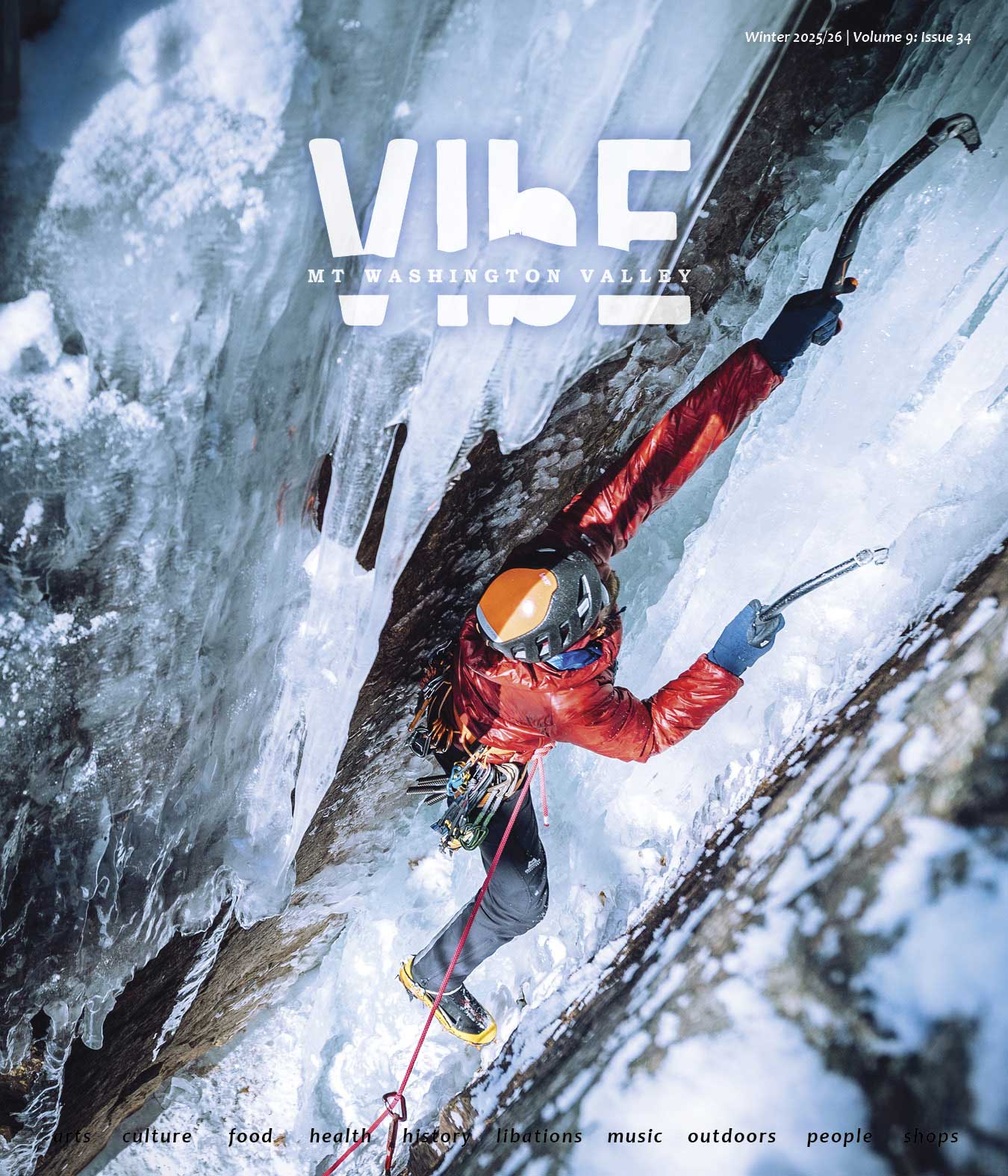By Jeffrey Fongemie, Mount Washington Avalanche Center
At the avalanche center, we talk daily about mountain hazards that have the potential to harm us—skiers/boarders, climbers, and hikers. Consider though, that as individuals and as a very large ski community, we have the ability to also cause harm to our mountain ecosystems. Think back to the last time you “topped out” a gully in the springtime. What was there? Snow? Blocks of exposed rock? Short, shrubby plants, and mats of low-growing vegetation?
The answer to all these questions is probably yes, which means we have a choice of which surfaces to travel on.

Trampling and disturbance of alpine vegetation are most commonly seen adjacent to trails and in high-traffic areas on Mount Washington, around huts and shelters, and near the Auto Road.
Often after a tiring climb up a 1,000-foot ski run or a technical climbing route, the last thing we think about is what is under our feet; and often the easiest thing to do is find the softest places to step and the path of least resistance. For fragile alpine flowers and vegetation, this can be a death sentence.
As a conservationist and former caretaker, I have spent countless hours talking with folks about the effects of trampling and leaving the durability of a trail or the snowpack. A common response is, “The plants have survived the harshest weather conditions on the planet. I don’t think stepping on them is any worse.” I wish this were true, but it is not. Alpine vegetation, including a handful of plants that grow nowhere else in the world, has done an incredible job at adapting to the harshest winter environment on the planet over thousands of years. These adaptations allow even the smallest flowering plants to survive through hurricane-force winds, deep snowpacks, sub-zero temperatures, and all types of precipitation.
Unfortunately, these plants have not had thousands of years to adapt to the patterns and impact of backcountry skiers and off-trail wanderers—and even a couple of bootprints can be catastrophic for these fragile species.
Trampling and disturbance of alpine vegetation are most commonly seen adjacent to trails and in high-traffic areas, including Mount Washington, around huts and shelters, and near the Auto Road; and increasingly, we are seeing this disturbance at the top of most of our popular ski runs.
Trampling is no one individual’s fault, but rather a product of our community travel habits in the mountains. Sure, Tuckerman has been dealing with this issue for years (and it shows) but with a huge increase in use to other ravines and more remote zones, we have a critical chance to evolve our travel behavior as a community.
Slackcountry on the Mt. Washington Auto Road
 Between lift-served and backcountry skiing is “slackcountry”— where you use your legs for some of the time, but you get a mechanical advantage to access your line.
Between lift-served and backcountry skiing is “slackcountry”— where you use your legs for some of the time, but you get a mechanical advantage to access your line.
There is no better way to fully experience the slackcountry than on the Mt. Washington Auto Road, typically opening for Drive Yourself tours to the summit in mid-May.
The timing of the road opening often coincides with fantastic spring skiing on the eastern-facing snowfields on Mt. Washington and steep gullies in the glacial cirques of the mountain.
Long after the ski lifts have closed, and while many turn their attention to mountain biking, climbing, or golfing, it’s a privilege to be able to drive to the summit and get in some spring turns with a relatively short hike back up to your car.
However, the skiable terrain is home to some of the most fragile and endangered plant species. And while these plants may look tough, and have evolved to withstand extreme winds and cold temperatures, they are not meant to be trampled by a ski boot or foot. Skiers must walk on rocks only, or follow existing trails.

Parking areas are well-designated and give hikers and skiers safe access to trails leading to spring skiing. WiseguyCreative.com photo
Like all Auto Road visitors, skiers must park in designated areas—not along the sides of the road. Parking lots are demarcated with boulders to prevent encroachment into the alpine.
And even though there is a road, there is no ski-patrol. Rescue efforts for an injured skier could take many long and cold hours. Skiers must choose a line well within their ability.
Voltaire (or Spiderman) said, “With great power comes great responsibility.” If you have the luxury of skiing late into May, it is imperative to act as stewards of the environment, respect the code, and encourage your friends to do the same.
So walk ONLY on the rocks, even if this means taking a circuitous route. Park in the designated areas ONLY, even if this means parking at the summit and walking on the road. And choose your ski-line wisely to keep everyone in your party and yourself safe.
Be sure to note the closing time of the Mt. Washington Auto Road, typically 4 p.m. in early May. This means the last time you can depart the summit is 4:45 p.m. If you linger too long, you’ll find yourself locked behind the gate at the base.
Visit www.mt-washington.com for hours and dates of operations, vehicle and weight restrictions, and Drive Yourself information.
WHAT CAN WE DO?
Most of the ski lines and climbing routes in the Presidentials are not right next to a trail, so traveling off-trail to access these routes is expected. How we do this as a community is incredibly important for the health of these ecosystems, and luckily, there are a few critical steps we can take to drastically mitigate alpine plant trampling.
Like the Leave No Trace principle says, travel and camp on durable surfaces. For us, this means walking on snow, rock, and trail whenever possible. We know how awkward it can be to walk on alpine schist in hard boots—just think of it as a little extra training, and get your poles out for balance.
Unless there is significant snow coverage, lose the idea that your approach route will be in a straight line. It will likely not be straight nor the path of least resistance. It might add a little distance and time to your day, but the mitigation of your negative effect on the ecosystem is well worth the cost of a few extra steps.
Talk to your group about this ethic, and spread the word.
Consider not going to a super remote objective that has all but melted out, and instead wait until there is good coverage. It’s not going anywhere!
As the Mt. Washington Auto Road opens up this year and many folks will take advantage of this mechanized ski access, Great Gulf is one of the areas where we see this impact most, in addition to the Eastside ravines.
If you do find yourself driving your car up to top-access big mountain skiing, please use your fresh legs to take an environmentally conscious approach to your line, which might include a winding route and lots of rock hopping.
Just as different climbing and skiing areas across the country have written and unwritten ethics and rules, we would love to see the White Mountain backcountry community wholeheartedly adopt this ethic as the norm of backcountry and spring backcountry skiing in our alpine zones. Like the adage, “You don’t know what you got until it’s gone,” we are incredibly lucky to have amazing ski terrain on our public lands right here in New Hampshire. For current and future generations, let’s take care of it.
—————
The Mount Washington Avalanche Center’s primary focus from Oct/Nov until the end of May is to provide avalanche safety information for people recreating, working, or traveling in the Presidential Range.
MWAC acts as the lead agency for search and rescue for the winter months and serves as a professional avalanche resource for people seeking assistance with snow and avalanche safety in the east.
For more information go to www.mountwashingtonavalanchecenter.org.








